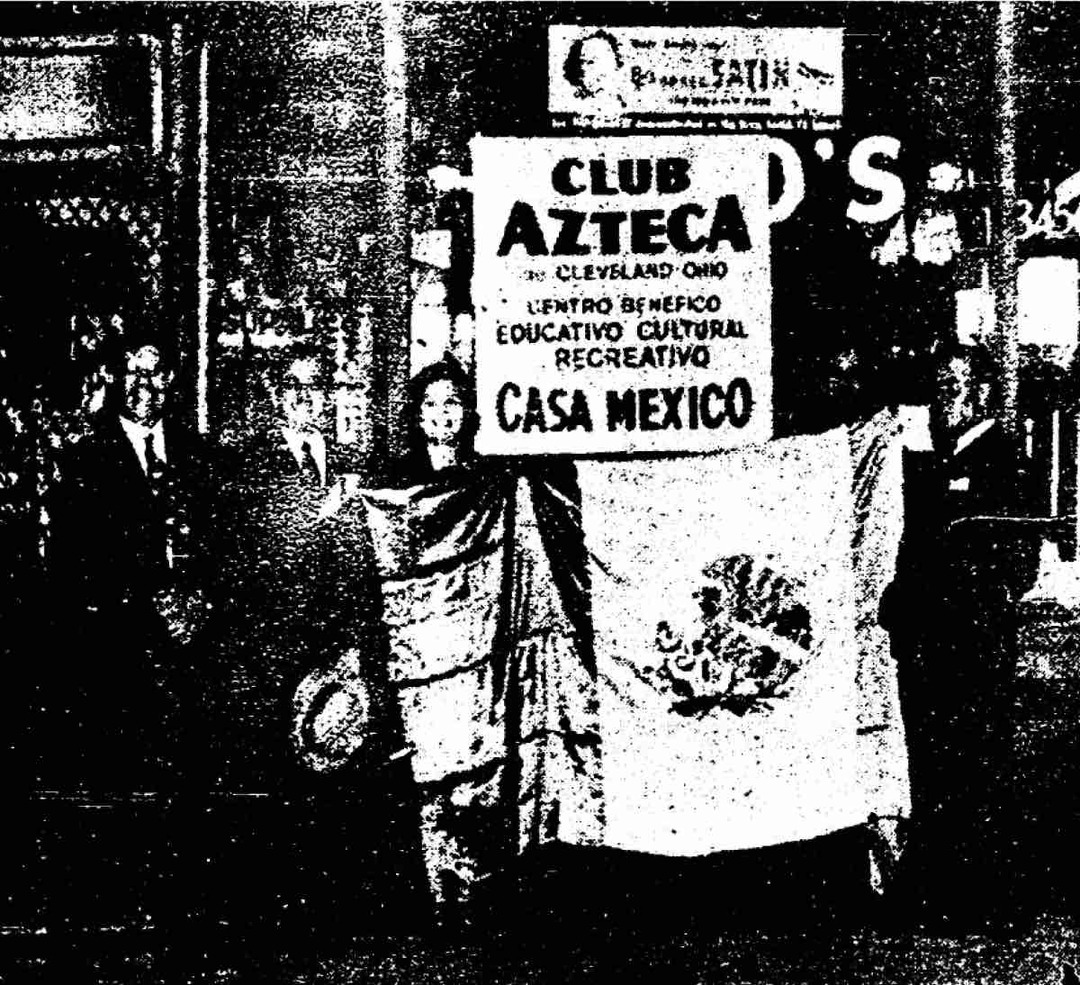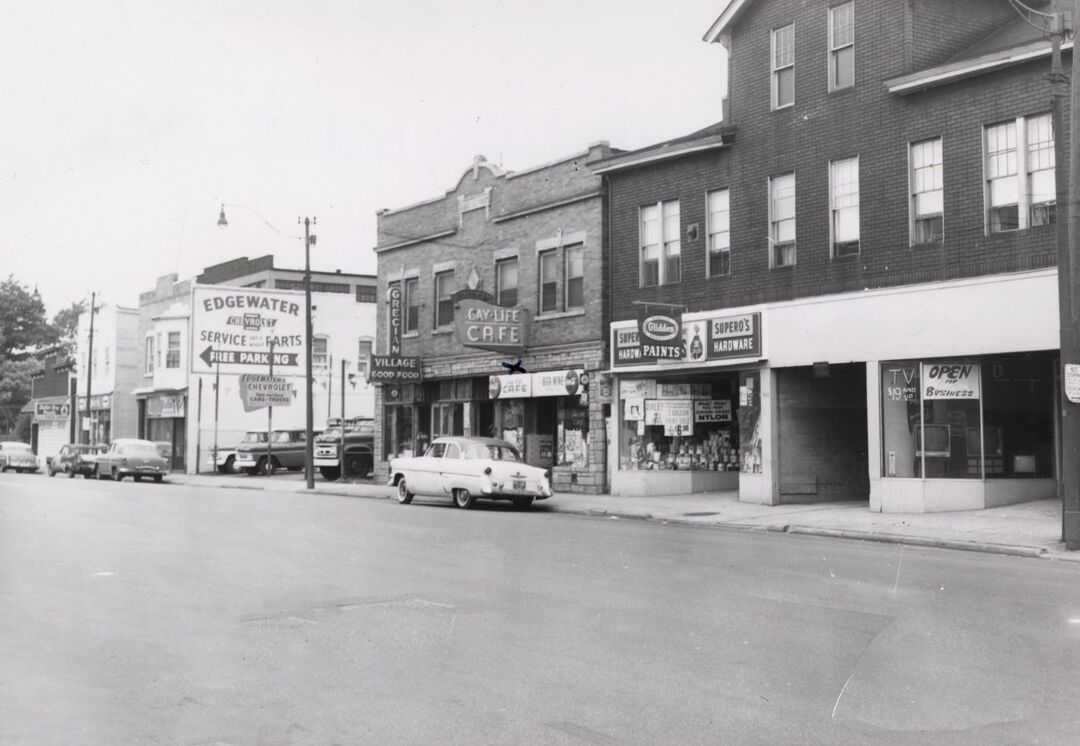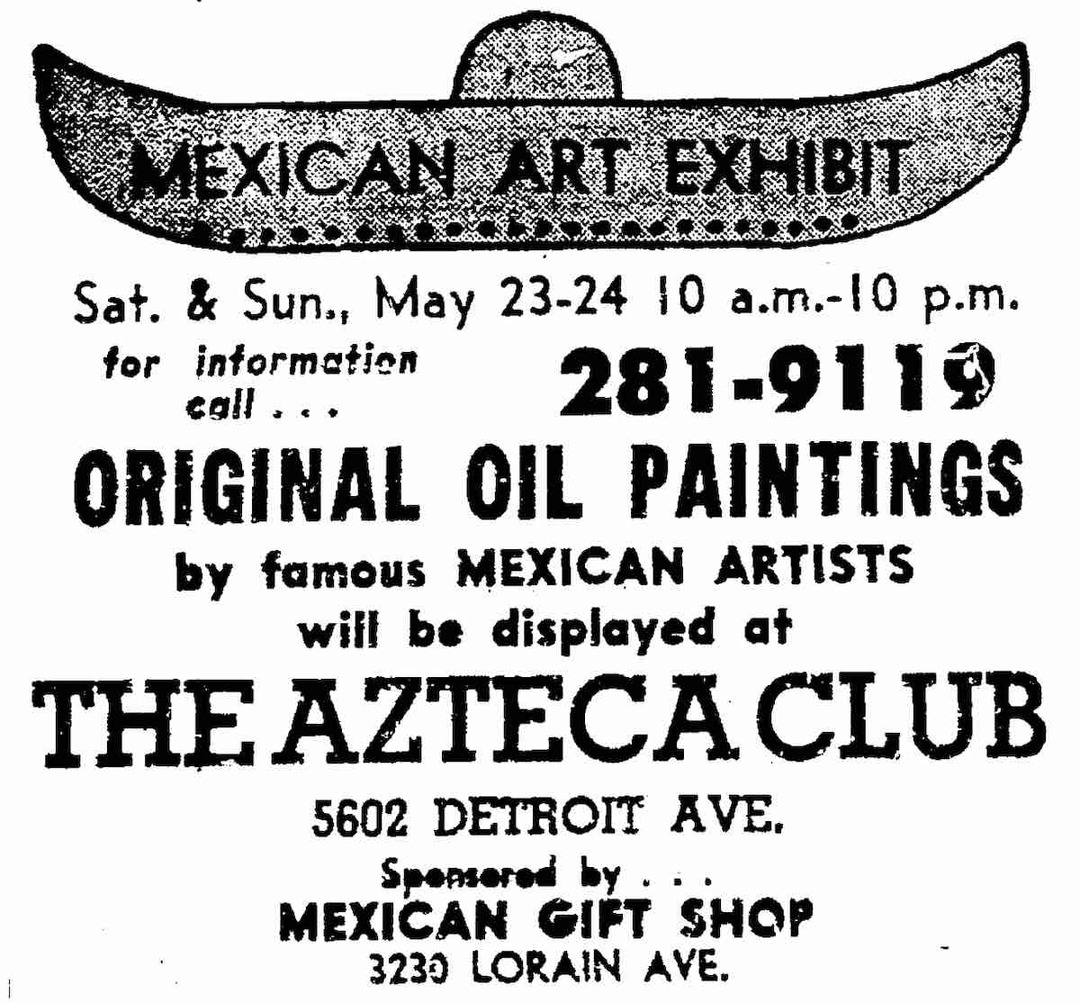
The autumn of 1951 was a momentous time for Cleveland's Mexican community. After years of raising funds through biannual fiestas and receiving gifts from Mexican organizations across the United States and even a contribution from the National Bank of Mexico, Club Azteca closed a deal to purchase a building for its first permanent home in the neighborhood that would later be known as Detroit Shoreway. The club served as a social and cultural center for Mexican Clevelanders for the next seven decades.
Club Azteca had its start in discussions among Mexican men who were taking English classes at the Hiram House settlement on Orange Avenue in the early part of the Great Depression. With the encouragement of a Hiram House language instructor, they decided in 1932 to establish Club Azteca as the first formal Mexican organization in Cleveland to provide a forum and safe haven for socializing, cultivating cultural traditions, and addressing common issues such as limited economic opportunity and discrimination that faced their community. The first Club Azteca president was Felix Delgado, who had left central Mexico to work as a Texas sharecropper before moving to Cleveland in 1923 to work on the Baltimore & Ohio Railroad.
Mexicans had been moving to Cleveland since the Mexican Revolution in 1910, and their numbers grew further during and after World War I. Like Delgado, many took jobs on the railroads, as well as in the steel mills, at a time when such jobs were being vacated by U.S. soldiers. Unlike some immigrant groups that concentrated in a single neighborhood, Mexicans had no single, well-defined center, and this remained true into the 1930s.
For its first twenty-five years, Club Azteca held biweekly or monthly meetings in the homes of members. The club also organized occasional larger events at venues such as Swiss Hall and St. Michael's Hall in Tremont, Ceska Sin Sokol Hall in Clark-Fulton, and Carpathia Hall in Detroit Shoreway. Such events included Club Azteca's commemorations of the anniversaries of Mexican Independence in 1820 and Mexico's defeat of the French army in the Battle of Puebla on May 5, 1862 (Cinco de Mayo). The event featured a historical pageant with members playing the part of Mexican military heroes.
When it incorporated in 1945, Club Azteca numbered more than 300 members. As the community and the club expanded after World War II, Club Azteca's leaders began to seek a permanent home closer to where many members now lived on the Near West Side. By 1951, the club had pooled enough resources to buy a former hardware store and apartment building at 5602 Detroit Avenue, which it fixed up over the next few years through "sweat equity." The new Club Azteca–Casa Mexico officially opened on June 15, 1957.
In addition to being a place to dance and socialize on weekend nights and to gather for potluck Sunday dinners, Casa Mexico provided important community services. It had a welcoming committee that delivered gift baskets to newcomers, and if a family arrived with nowhere to stay, the club found temporary quarters by tapping its members. The club also served as a clearinghouse for information that new migrants needed about where to buy food and how to do a myriad of daily activities in the city. For blue-collar workers who lived in roominghouses without kitchens, Club Azteca provided homemade meals.
Although Cleveland's Hispanic communities remained distinct, certain moments drew them together. In 1978, for example, the annual celebration of the feast day of Our Lady of Guadalupe (the patron saint of Mexico) at St. Michael's Hall encompassed not only Mexican but also Puerto Rican Clevelanders. The celebration included both Mexican and Puerto Rican music, and foods included the familiar enchiladas, burritos, and tacos alongside pastellas, a kind of Puerto Rican pastry. The festivities included a promenade by the queens and princesses of Club Azteca and its Puerto Rican counterpart, Club San Lorenzo, an organization founded in 1969 by natives of San Lorenzo, Puerto Rico. In 1990, a new event called Festival 90 drew together Club Azteca, Club San Lorenzo, and Club Alma Yaucana, another organization founded in 1961 to welcome newcomers from Yauco, Puerto Rico.
Although it was cooperating with other organizations, Club Azteca was beginning to suffer financial challenges in the 1980s, leading it to use its Detroit Avenue hall primarily as a nightclub to generate much-needed revenue. Club Azteca hosted "Puerto Rican Night" dances on Saturdays, an appeal to a community that was about five times larger than the city's Mexican-American community by 1990. By the end of the twentieth century, in spite of continuing to have many "social members" who enjoyed its nightclub, Club Azteca had dwindled to only 67 voting members, which led its officers to worry about the club's future.
Indeed, within a few more years Club Azteca's building fell into disuse. During this difficult time, Ruth Rubio-Pino, whose parents had managed the club from the mid-1950s until 2007, became president under a new Club Azteca administration in 2015. She tried to revive the struggling organization but found little support and the headquarters building now essentially beyond repair. After the building went into foreclosure in 2019, Club Azteca's small remaining membership was able to relieve its financial burden by transferring its building to the Cuyahoga Land Bank in 2020.
When a developer acquired the building as part of several parcels it was assembling to erect a large apartment building, it and Club Azteca agreed to develop a plan for incorporating the organization's heritage into the new building's design. Although Casa Mexico was demolished in 2021, exactly 70 years after its purchase, Club Azteca continues to explore possibilities for creating a space to honor its long legacy as a community anchor for Mexican culture and social action in Northeast Ohio.
___
El otoño de 1951 fue un momento crucial para la comunidad mexicana de Cleveland. Después de años de recaudar fondos mediante fiestas bianuales y de recibir regalos de organizaciones mexicanas a lo largo y ancho de los Estados Unidos, e incluso una contribución del Banco Nacional de México, el Club Azteca llegó a un acuerdo para comprar un edificio para su primera sede permanente en el barrio que más tarde sería conocido como la Detroit Shoreway. El club sirvió como un centro cultural y social para los habitantes mexicanos de Cleveland durante las siguientes siete décadas.
El Club Azteca tuvo su inicio en conversaciones entre los hombres mexicanos que estaban tomando clases en el asentamiento social de la Hiram House en la avenida Orange en los comienzos de la Gran Depresión. Alentados por un instructor de lenguas de Hiram House, decidieron en 1931 establecer el Club Azteca como la primera organización formal mexicana en Cleveland para proveer un foro y un lugar seguro para socializar, cultivar las tradiciones culturales y ocuparse de cuestiones de interés común como las limitades oportunidades económicas y la discriminación con la que se enfrentaban en sus comunidades. El primer presidente del Club Azteca fue Félix Delgado, que había dejado el centro de México para trabajar como aparcero en Texas, antes de mudarse a Cleveland para trabajar en el ferrocarril de Baltimore & Ohio.
Los mexicanos se habían estado mudando a Cleveland desde la Revolución Mexicana en 1910 y sus cifras habían crecido más durante y después de la Primera Guerra Mundial. Como Delgado, muchos tomaron trabajos en los ferrocarriles, así como en las siderurgias, en un tiempo en el que esos trabajos estaban siendo abandonados por los soldados de los Estados Unidos. A diferencia de otros grupos inmigrantes que se concentraban en un único barrio, los mexicanos no tenían un centro único y bien definido, y esto siguió siendo cierto hasta avanzados los años treinta.
Durante sus primeros veinticinco años, el Club Azteca tuvo reuniones cada dos semanas o mensualmente en las casas de sus miembros. El club también organizaba eventos más grandes en espacios como el Swiss Hall y el Hall de St. Michael en Tremont, el Ceska Sin Sokol Hall en Clark-Fulton y el Carpathia Hall en la Detroit Shoreway. Estos eventos incluían las conmemoraciones del Club Azteca de los aniversarios de la independencia de México en 1820 y de la derrota del ejército francés en la Batalla de Puebla el 5 de mayo de 1862 (Cinco de Mayo). Los eventos incluyeron una representación histórica con los miembros del club interpretando el papel de los héroes militares mexicanos.
Cuando se estableció formalmente en 1945, el Club Azteca contaba con más de 300 miembros. Según la comunidad y el club se expandieron después de la Segunda Guerra Mundial, los líderes del Club Azteca empezaron a buscar una sede permanente más cerca de donde muchos miembros vivían entonces en el Near West Side. Para 1951, el club había juntado suficientes recursos para comprar una antigua ferretería y edificio de apartamentos en el número 5601 de la avenida Detroit, que arreglaron a lo largo de los siguientes años trabajando sin remuneración. El nuevo Club Azteca-Casa México oficialmente se inauguró el 15 de junio de 1957.
Además de ser un lugar para bailar y socializar en las noches de los fines de semana, y para reunirse para cenas compartidas los domingos, la Casa México proveyó servicios comunitarios importantes. Tenía un comité de bienvenida que repartía cestas de regalos a los recién llegados, y si una familia llegaba sin un lugar en el que quedarse, el club les encontraba un alojamiento temporal valiéndose de sus miembros. El club también servía como un centro para distribuir información que los nuevos migrantes necesitaba sobre dónde comprar comida y cómo hacer múltiples actividades diarias en la ciudad. Para los trabajadores que vivían en pensiones/casas de huéspedes sin cocinas, el Club Azteca proveía comida casera.
Aunque las comunidades hispanas de Cleveland poseían características distintas, ciertos momentos las juntaban. En 1978, por ejemplo, la celebración anual del Día de Nuestra Señora de Guadalupe (la patrona de México) en el Hall de St. Michael reunió no solamente a los mexicanos de Cleveland, sino también a los puertorriqueños. La celebración incluyó tanto música mexicana como puertorriqueña, y las comidas incluyeron enchiladas, burritos y tacos, además de pastelillos puertorriqueños. Las festividades incluyeron un desfile ceremonial de las reinas y las princesas del Club Azteca y de su contraparte puertorriqueña, el Club San Lorenzo, una organización fundada en 1969 por los nativos de San Lorenzo, Puerto Rico. En 1990, un nuevo evento, llamado Festival 90, juntó al Club Azteca, al Club San Lorenzo y al Club Alma Yaucana, otra organización fundada en 1961 para dar la bienvenida a los recién llegados de Yauco, Puerto Rico.
Aunque estaba cooperando con otras organizaciones, el Club Azteca estaba comenzando a enfrentarse a retos financieros en los años 80, lo que llevaría al uso de su sala en la avenida Detroit como discoteca para generar unos ingresos que se necesitan mucho. El Club Azteca acogía los bailes de la “Noche Puertorriqueña” los sábados, un llamamiento a una comunidad que, para 1990, era cinco veces más grande que la comunidad mexicanoamericana. Para el final del siglo XX, a pesar de que continuaba teniendo muchos “miembros sociales” que disfrutaban de su club nocturno, el Club Azteca se había reducido a solamente 67 miembros con derecho a votación, lo que llevó a sus oficiales a preocuparse por el futuro del club.
En efecto, en unos cuantos años más, el edificio del Club Azteca cayó en desuso. Durante estos tiempos difíciles, Ruth Rubio-Pino, cuyos padres habían administrado el club desde mediados de los años 50 hasta 2007, se convirtió en presidenta bajo una nueva administración del Club Azteca en 2015. Ella intentó revivir la organización, que se encontraba en dificultades, pero encontró poco apoyo y el edificio de su sede ahora en condición esencialmente irreparable. Después de que el edificio se enfrentase a un embargo en 2019, la reducida membresía que le quedaba al Club Azteca pudo aliviar su carga financiera mediante la transferencia de su edificio al Cuyahoga Land Bank en 2020.
Cuando un promotor adquirió el edificio como parte de varias parcelas que estaba reuniendo para erigir un edificio de apartamentos grande, este y el Club Azteca acordaron desarrollar un plan para incorporar la herencia de la organización en el diseño del nuevo edificio. Aunque la Casa México fue demolida en 2021, exactamente 70 años después de su compra, el Club Azteca continúa explorando la posibilidad de crear un espacio para honrar su legado longevo como pilar de la comunidad para la cultura mexicana y la acción social en el noroeste de Ohio.
Images






